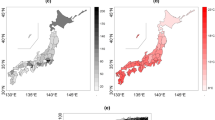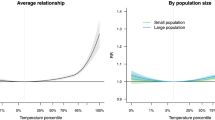Abstract
Known conceptual and technical limitations of mainstream environmental health data analysis have directed research to new avenues. The goal is to deal more efficiently with the inherent uncertainty and composite space-time heterogeneity of key attributes, account for multi-sourced knowledge bases (health models, survey data, empirical relationships etc.), and generate more accurate predictions across space-time. Based on a versatile, knowledge synthesis methodological framework, we introduce new space-time covariance functions built by integrating epidemic propagation models and we apply them in the analysis of existing flu datasets. Within the knowledge synthesis framework, the Bayesian maximum entropy theory is our method of choice for the spatiotemporal prediction of the ratio of new infectives (RNI) for a case study of flu in France. The space-time analysis is based on observations during a period of 15 weeks in 1998–1999. We present general features of the proposed covariance functions, and use these functions to explore the composite space-time RNI dependency. We then implement the findings to generate sufficiently detailed and informative maps of the RNI patterns across space and time. The predicted distributions of RNI suggest substantive relationships in accordance with the typical physiographic and climatologic features of the country.










Similar content being viewed by others
References
Allen, L. J. S., & Burgin, A. M. (2000). Comparison of deterministic and stochastic SIS and SIR models in discrete time. Mathematical Biosciences, 163, 1–33.
Angulo, J.M., & Christakos, G. (2010). A stochastic model of spatiotemporal infectious disease spread. SDSU Medical Geography Res Rep 12–09.
Angulo, J.M., Yu, H-L, Langousis, A., Madrid, D., and Christakos, G. (2012). Modeling of space-time infectious disease spread under conditions of uncertainty. International Journal of Geographical Information Science. In press.
Arrow, K., Dasgupta, P., & Maler, K.-G. (2003). Evaluating projects and assessing sustainable development in imperfect economics. Environmental and Resource Economics, 26, 647–85.
Atkinson, P. M. (1993). The effect of spatial resolution on the experimental variogram of airborne MSS imagery. International Journal of Remote Sensing, 14, 1005–11.
Banerjee, S., Carlin, B. P., & Gelfand, A. E. (2004). Hierarchical modeling and analysis for spatial data (monographs on statistics and applied probability). Boca Raton: Chapman & Hall/CRC Press.
Bayraktar, H., & Turalioglu, F. S. (2005). A Kriging-based approach for locating a sampling site—in the assessment of air quality. Stochastic Environmental Research and Risk Assessment, 19, 301–5.
Bivand, R. S., Pebesma, E. J., & Gómez-Rubio, V. (2008). Applied spatial analysis with R. New York: Springer.
Bossak, B. H., & Welford, M. R. (2009). Did medieval trade activity and a viral etiology control the spatial extent and seasonal distribution of Black Death mortality? Medical Hypotheses, 72, 749–752.
Chen, C.-C., Wu, K.-Y., & Chang, M. J. W. (2004). A statistical assessment on the stochastic relationship between biomarker concentrations and environmental exposures. Stochastic Environmental Research and Risk Assessment, 18, 377–85.
Choi, K.-M., Serre, M. L., & Christakos, G. (2003). Efficient mapping of California mortality fields at different spatial scales. Journal of Exposure Analysis and Environmental Epidemiology, 13, 120–33.
Choi, K. M., Yu, H.-L., & Wilson, M. L. (2007). Spatiotemporal statistical analysis of influenza mortality risk in the State of California during the period 1997–2001. Stochastic Environmental Research and Risk Assessment, 22(Supplement 1), 15–25.
Christakos, G. (1991a). On certain classes of spatiotemporal random fields with application to space-time data processing. IEEE Trans Systems, Man, and Cybernetics, 21, 861–75.
Christakos, G. (1991b). Some applications of the BME concept in Geostatistics. In Fundamental Theories of Physics, (pp. 215–229). Amsterdam: Kluwer Acad Publ.
Christakos, G. (1992). Random field models in earth sciences. San Diego: Academic.
Christakos, G. (1998). Spatiotemporal information systems in soil and environmental sciences. Geoderma, 85, 141–79.
Christakos, G. (2000). Modern spatiotemporal geostatistics. New York: Oxford University Press.
Christakos, G. (2008). Bayesian Maximum Entropy. In M. Kanevski (Ed.), Advanced mapping of environmental data: Geostatistics, machine learning, and Bayesian maximum entropy (pp. 247–306). New York: Wiley.
Christakos, G. (2010). Integrative problem-solving in a time of decadence. New York: Springer.
Christakos, G., & Hristopulos, D. T. (1998). Spatiotemporal environmental health modelling: A Tractatus Stochasticus. Boston: Kluwer Acad Publ.
Christakos, G., & Kolovos, A. (1999). A study of the spatiotemporal health impacts of ozone exposure. Journal of Exposure Analysis and Environmental Epidemiology, 9, 322–335.
Christakos, G., Bogaert, P., & Serre, M. L. (2002). Temporal GIS. New York: Springer.
Christakos, G., Kolovos, A., Serre, M. L., & Vukovich, F. (2004). Total ozone mapping by integrating data bases from remote sensing instruments and empirical models. IEEE Transactions on Geoscience and Remote Sensing, 42, 991–1008.
Clayton, D., & Hills, M. (1993). Statistical models in epidemiology. New York: Oxford University Press.
Deutsch, C. V., & Journel, A. G. (1992). Geostatistical Software Library and User's Guide. Oxford: Oxford Univ Press.
Douaik, A., van Meirvenne, M., Toth, T., & Serre, M. L. (2004). Space-time mapping of soil salinity using probabilistic BME. Stochastic Environmental Research and Risk Assessment, 18, 219–27.
Escudero, L. F., Ortega, E. M., & Alonso, J. (2009). Variability comparisons for some mixture models with stochastic environments in biosciences and engineering. Stochastic Environmental Research and Risk Assessment, 24, 199–209.
Gneiting, T. (2002). Nonseparable, stationary covariance functions for space-time data. JASA, 97(458), 590–600.
Goovaerts, P. (2008). Kriging and semivariogram deconvolution in the presence of irregular geographical units. Mathematical Geosciences, 40, 101–128.
Hethcote, H. W. (1994). A thousand and one epidemic models. In S. A. Levin (Ed.), Frontiers in Mathematical Biology, Lecture Notes in Biomathematics (Vol. 100). Berlin: Springer.
Heuvelink, G. B. M. (1998). Error propagation in environmental modelling with GIS. London: Taylor & Francis.
Kolovos, A., Christakos, G., Hristopulos, D. T., & Serre, M. L. (2004). Methods for generating non-separable spatiotemporal covariance models with potential environmental applications. Advances in Water Resources, 27, 815–30.
Kolovos, A., Yu, H.-L., & Christakos, G. (2006). SEKS-GUI v.0.6 User Manual. San Diego: Dept of Geography, San Diego State University.
Kuo, H. I., Lu, C.-L., Tseng, W.-C., & Li, H.-A. (2009). A spatiotemporal statistical model of the risk factors of human cases of H5N1 avian influenza in Southeast Asian countries and China. Journal of Public Health, 123, 188–193.
Law, D. C. G., Bernstein, K., Serre, M. L., Schumacher, C. M., Leone, P. A., et al. (2006). Modeling an early syphilis outbreak through space and time using the Bayesian maximum entropy approach. Annals of Epidemiology, 16, 797–804.
Lee, S.-J., Balling, R., & Gober, P. (2008). Bayesian maximum entropy mapping and the soft data problem in urban climate research. Annals of the Association of American Geographers, 98, 309–22.
Liao, D., Peuquet, D. J., Duan, Y., Whitsel, E. A., Dou, J., et al. (2006). GIS approaches for the estimation of residential-level ambient PM concentrations. Environmental Health Perspectives, 114, 1374–80.
Ma, C. (2008). Recent developments on the construction of spatio-temporal covariance models. Stochastic Environmental Research and Risk Assessment, 22, 39–47.
Moore, D. A., & Carpenter, T. E. (1999). Spatial analytical methods and geographic information systems: Use in health research and epidemiology. Epidemiology Reviews, 21, 143–61.
Porcu, E., Mateu, J., & Saura, F. (2008). New classes of covariance and spectral density functions for spatio-temporal modelling. Stochastic Environmental Research and Risk Assessment, 22, 65–79.
Renshaw, E. (1993). Modelling biological populations in space and time. Cambridge: Cambridge University.
Saito, H., McKenna, S. A., Zimmerman, D. A., & Coburn, T. C. (2005). Geostatistical interpolation of object counts collected from multiple strip transects: Ordinary Kriging versus finite domain Kriging. Stochastic Environmental Research and Risk Assessment, 19, 71–85.
Schabenberger, O., & Gotway, C. A. (2005). Statistical methods for spatial data analysis. Boca Raton: Chapman & Hall/CRC Press.
Serre, M. L., & Christakos, G. (1999). Modern geostatistics: Computational BME analysis in the light of uncertain physical knowledge—the Equus Beds study. Stochastic Environmental Research and Risk Assessment, 13, 1–26.
Serre, M. L., Kolovos, A., Christakos, G., & Modis, K. (2003). An application of the holistochastic human exposure methodology to naturally occuring Arsenic in Bangladesh drinking water. Risk Analysis, 23, 515–28.
Stein, A., van der Meer, F., & Gorte, B. (1999). Spatial statistics for remote sensing. Dordrecht: Kluwer.
Wong, D. W. S., & Lee, J. (2005). Statistical analysis of geographic information with ArcView GIS and ArcGIS. New York: Wiley.
Wu, J. L., Wang, J. F., Meng, B., Chen, G., Pang, L., et al. (2004). Exploratory spatial data analysis for the identification of risk factors to birth defects. BMC Public Health, 4, 23.
Yu, H.-L., Ku, S.-C., Yang, C.-H., Cheng, T.-J., & Chen, L. (2011). Assessment of areal average air quality level over irregular areas: A case study of PM10 exposure estimation in Taipei (Taiwan). In: F. Nejadkoorki (Ed.), Advanced Air Pollution. InTech, http://www.intechopen.com/articles/show/title/assessment-of-areal-average-air-quality-level-over-irregular-areas-a-case-study-of-pm10-exposure-est
Acknowledgments
Partial support for this work was provided by a grant from the California Air Resources Board, USA (grant no. 55245A). Alexander Kolovos was supported by SpaceTimeWorks, LLC. José M. Angulo was partially supported by grants MTM2009-13250 of the SGPI, and P08-FQM-3834 of the Andalusian CICE, Spain.
Conflict of interest
The authors declare that they have no conflict of interest, nor has this ever been an issue in question during the entire period of research for this paper.
Author information
Authors and Affiliations
Corresponding author
Rights and permissions
About this article
Cite this article
Kolovos, A., Angulo, J.M., Modis, K. et al. Model-driven development of covariances for spatiotemporal environmental health assessment. Environ Monit Assess 185, 815–831 (2013). https://doi.org/10.1007/s10661-012-2593-1
Received:
Accepted:
Published:
Issue Date:
DOI: https://doi.org/10.1007/s10661-012-2593-1




